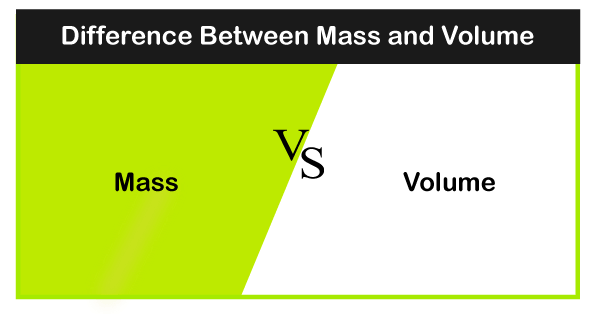Difference between Mass and VolumeWe all have heard about mass, weight, volume, height, etc., in our physics and mathematics lectures. All we know is that these things help us in calculating some particular things about objects. Out of these all terms, mass and volume are the ones we are most confused about. We think that mass and volume mean the same. But it is not so. Both differ in certain aspects. So, let us discuss this in detail. Mass is considered a property associated with a physical body that reacts when it is in motion. In layman's terms, when the net force is applied to an object, the object's resistance results in a change in the object's position, which is called mass. As we know, inertia is the primary property of all objects; therefore, mass is the quantitative measure of inertia. Mass and change in motion are proportionate to each other, i.e., the greater mass of the object results in a slight change as not much motion occurs. The strength and gravitation of an object also determine the mass of object. 
The SI unit of mass is Kg (Kilogram). We must not be confused about mass and weight. Mass is not like weight. However, the mass of an object is calculated by its weight. But still, they are not the same. It is interesting to know that a particular object can weigh differently despite having the same mass. For instance, an object will weigh less on the moon than on earth because of its low gravity. But the mass of the object is the same. This happens because mass is considered a property that helps us determine the strength of a particular object. Now, how the mass of an object is calculated? Many theorists have given their theories for calculating the mass of an object. Let us look at the three ways in which we can calculate the mass.
These are the three theories that help us in determining the mass of an object. Now, you must be wondering about inertia and inertial mass. The properties of both inertia and inertial mass are the same. And mass is directly related to inertia. Let us understand this with the help of Newton's three laws of motion.
Well, in the case of calculating the mass, we can apply the second law of motion. Now, let us look at some of the units of mass.
These are some of the ways for calculating the mass of an object. However, the object is not just limited to earth. There are other ways of calculating the mass of an object. For instance, solar mass is used for measuring the mass of the sun in space. This concept is used in astronomy by scientists. Now, let us discuss some key points regarding the volume of an object. Volume is defined as the quantity of 3-D space, particularly a solid, plasma, gas, or liquid. The SI unit of volume is the cubic metre. For instance, the volume of a container is calculated by the volume of water it can hold. Shapes can be one-dimensional, two-dimensional, or three-dimensional. Now, let us look at some of the units of volume. The standard unit of volume is the cubic metre. Another way of calculating the volume of an object is through litre (L). The formula is; 1 Cubic Metre = 1000 litres. The volume of liquid is also measured through millilitres. The formula is; 1 millilitre = 1 cubic centimetre. This formula is used for calculating small amounts of fluids. In the case of larger amounts of fluid, the volume is calculated in megalitre. The formula is; 1000 cubic metres = 1 megalitre. Other ways of calculating the volume include:
These are some of the other units that are used for calculating the volume of an object. The volume of a particular object is calculated in various academic fields like calculus, differential geometry, thermodynamics, etc. Volume computation is one of the ways used for calculating the volume of an object. In this method, the volume is calculated by examining the algorithms so that the object's exact computation comes out. In thermodynamics, the volume describes the thermodynamic state of an object. Volume is also considered a quantity of an object dependent upon thermodynamic properties like pressure, temperature, etc. Now, let us look at some of the major differences between mass and volume.
These are the major differences between the mass and volume of an object. We often get confused between the two. But it is important to understand the properties of these terms and differentiate between the two. Both mass and volume are used to measure the weight of an object. But the methods applied are completely different. Thus, both terms carry different meaning and properties.
Next TopicDifference between
|
 For Videos Join Our Youtube Channel: Join Now
For Videos Join Our Youtube Channel: Join Now
Feedback
- Send your Feedback to [email protected]
Help Others, Please Share









